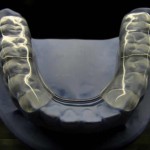
Temporomandibular disorders are though to affect between 5-12% of the world’s population and sleep bruxism between 3.5% to 49.6% of younger generations and 1-15% of adults. The hard occlusal splint is considered to be a minimally invasive approach to reducing the signs and symptoms of both sleep bruxism and temporomandibular disorders. A number of disocclusion guides have been incorporated in splint design including, canine guidance (CG), bilateral balanced occlusion (BBO), anterior guidance, and molar guidance although their effectiveness remains controversial.
The aim of this review was to assess the effect of disocclusion guidance on occlusal splints for sleep bruxism (SB) and temporomandibular disorders (TMD).
Methods
A protocol was registered in the PROSPERO database. Searches were conducted in the following databases Cochrane, Embase, Latin American and Caribbean Health Sciences Literature, LIVIVO, PubMed (including Medline), Scopus, Web of Science, Google Scholar, OpenGrey, and ProQuest Dissertation and Thesis. Randomised controlled trials (RCTs), non-randomised clinical trials (NRCTs), and before-and-after studies investigating occlusal splints with different types of guidance in adolescents (12-18 years old), adults, and older adults with either sleep bruxism (SB) or temporomandibular disorders (TMD) were considered.
Two reviewers independently selected studies and extracted data with disagreements being resolved by a third reviewer. Risk of bias was assessed by two reviewers independently using Joanna Briggs Institute Critical Appraisal Checklists, according to study design. Dichotomous outcomes were reported as percentages and continuous variables as means with standard deviations (SD). Meta-analyses were not conducted because of study heterogeneity so a narrative summary was undertaken. Certainty of the evidence was assessed using the Grading of Recommendations Assessment, Development and Evaluation (GRADE) approach.
Results
- 15 studies (5 RCTs, 5 NRCTs, 6 before and after studies) involving a total of 620 patients were included.
- Studies were conducted in Brazil (5), China (2), Croatia (2), England (1), Israel (1), Italy (1), Saudi Arabia (1), Singapore (1), and the USA (2).
- 11 studies assessed TMD and 2 studies SB.
- Follow-up periods ranged from 1 week to 6 months.
- One RCT was considered to be at high risk of bias, one at low risk and 3 at moderate risk.
- 3 NRCTs were considered to be at low risk of bias and 2 at moderate risk.
- Of the before and after studies 2 were high risk 2 low risk and 2 at moderate risk.
- 14 studies investigated CG, 3 BBO and 2 molar guidance with anterior guidance and group function being assessed in single papers.
- A number of outcomes were assessed and with the exception of bite force the certainty of the available evidence was very low (see table).
| No. of studies | GRADE certainty of Evidence | |
| Pain | 11 | Very low |
| Maximum mouth opening | 6 | Very low |
| Temporomandibular joint sounds | 4 | Very low |
| Headache | 1 | Very low |
| TMD index | 4 | Very low |
| Muscle activity | 5 | Very low |
| Bite force | 1 | Moderate |
| Sleep quality | 3 | Very low |
| Splint comfort | 2 | Very low |
Conclusions
The authors concluded: –
It is suggested there is not enough evidence to support that there are any specific kind of guidance responsible for improving evaluated outcomes on TMD and SB.
Comments
The authors pre-registered a protocol in PROSPERO and searched a good range of relevant databases for this question. They included a range of study designs but only managed to include two studies addressing sleep bruxism. The authors noted a high heterogeneity in the studies in relation to both TMD diagnostic criteria and assessment methods. A good narrative summary of the included studies was provided but the sample sizes are generally small and only a only 5 of the included studies were considered to be at low risk of bias. This review in common with other reviews of the use of splints for TMD (Dental Elf – 20th Jul 2020, Dental Elf – 17th Mar 2021) highlights common issues in the available evidence including variation in diagnostic criteria, small sample sizes and variation in the outcomes reported. While further research is needed it would benefit from following recognised standard for the conduct and reporting of trials the use of common diagnostic criteria and outcome sets.
Links
Primary Paper
Denardin ACS, do Nascimento LP, Valesan LF, Da Cas CD, Pauletto P, Garanhani RR, Januzzi E, Hilgert LA, de Souza BDM. Disocclusion guides in occlusal splints on temporomandibular disorders and sleep bruxism: a systematic review. Oral Surg Oral Med Oral Pathol Oral Radiol. 2023 Jan;135(1):51-64. doi: 10.1016/j.oooo.2022.07.009. Epub 2022 Jul 23. PMID: 36241594.
Other references
Dental Elf – 3rd Feb 2021
Dental Elf – 17th Mar 2021
Occlusal stabilisation appliances for temporomandibular disorders
Dental Elf – 20th Jul 2020
Occlusal splints for the management of temporomandibular disorders
